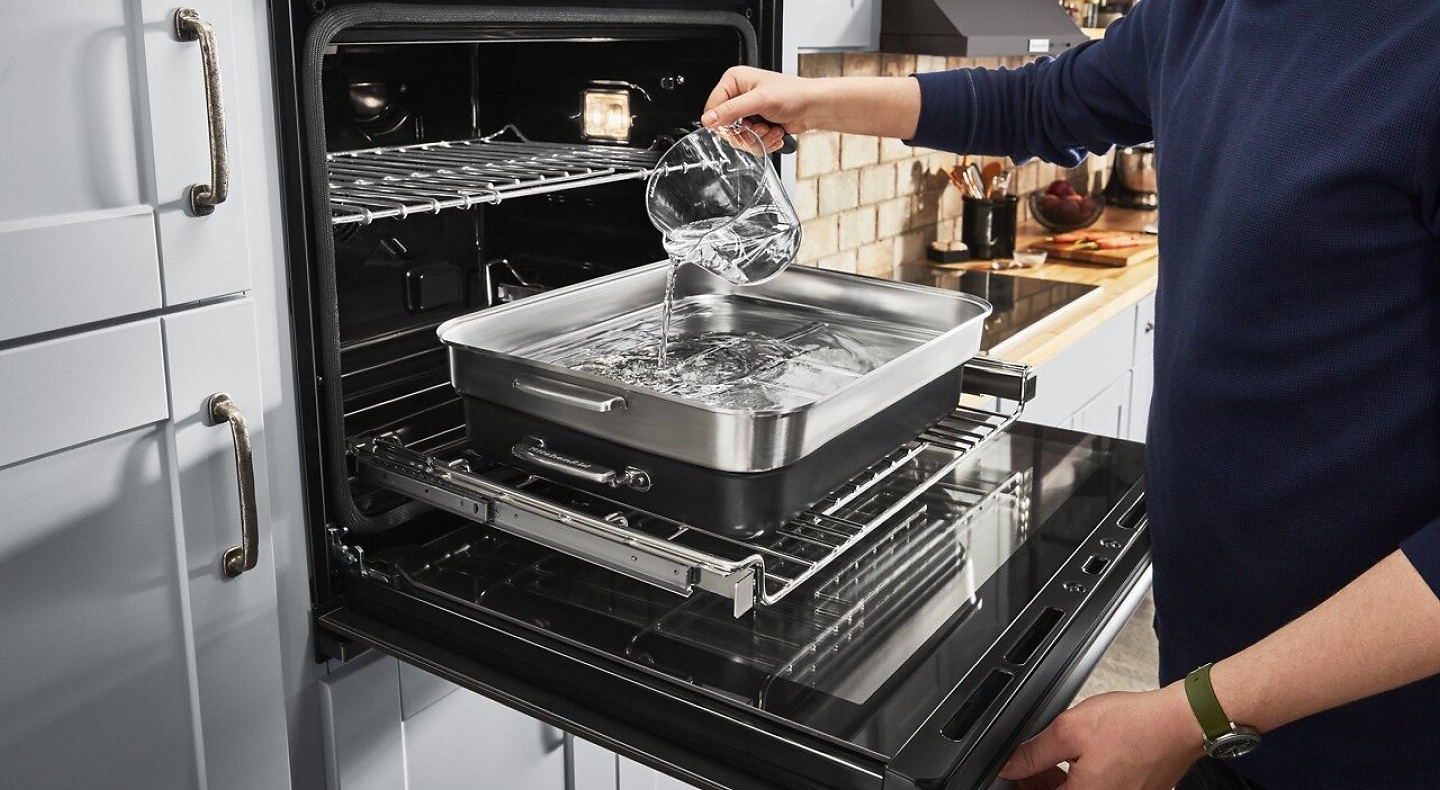Choosing the right cleaning method for your oven can make all the difference in maintaining its efficiency and hygiene. You want to ensure your oven stays spotless without the hassle of scrubbing and harsh chemicals.
That’s where the debate between steam clean and self-clean ovens comes into play. As you stand in front of your oven, wondering which option will save you time and effort, it’s crucial to understand the benefits and drawbacks of each method.
Imagine spending less time cleaning and more time enjoying delicious meals with family and friends. Dive into this article to discover which cleaning method will transform your kitchen experience and keep your oven in top shape. Don’t miss out on the secrets to a cleaner, healthier oven that awaits you!
Steam Clean Method
The Steam Clean Method offers a simple way to clean ovens. It uses water and heat to loosen dirt and grime. Many modern ovens come with this feature. This cleaning option is quick and efficient. It is less intense than self-clean cycles. Read on to learn how it works and its benefits.
How It Works
The steam clean process begins by adding water to the oven’s bottom. Next, you select the steam clean setting. The oven heats the water, creating steam. This steam helps soften baked-on food and spills. After the cycle, you wipe the interior with a cloth. No harsh chemicals are needed.
Pros Of Steam Cleaning
The steam clean method is gentle on the oven. It uses low heat, reducing wear on oven parts. This method saves energy compared to self-cleaning. It is also quicker, often taking less than an hour. Steam cleaning is safe, with minimal fumes or odors.
Cons Of Steam Cleaning
Steam cleaning may not remove heavy grime. Stubborn stains might need manual scrubbing. It might not be suitable for older ovens. Some users find it less effective than self-cleaning. Limited to cleaning light messes only.

Credit: www.youtube.com
Self Clean Method
Choosing between steam clean and self clean oven methods can be tricky. Steam clean uses water and heat to soften residues, making it gentler on your appliance. Self clean, on the other hand, heats to high temperatures to burn off spills, offering a deep clean but with a longer cycle.
Cleaning your oven can be a daunting task, especially when you’re faced with stubborn grease and spills. The Self Clean Method offers a hands-off approach to tackle this chore. This method uses high temperatures to burn off residue, turning it into ash that you can easily wipe away.How It Works
The self-cleaning feature heats your oven to extremely high temperatures, typically between 800°F and 1,000°F. This intense heat incinerates food particles and spills, leaving behind a fine ash. Once the cycle is complete, you simply wipe out the ash with a damp cloth. Did you know that this method can take several hours? It’s not a quick fix, but it’s effective. You might want to plan to be out of the kitchen while it runs, as the oven locks itself for safety.Pros Of Self Cleaning
One of the main advantages is that it requires minimal effort. You just set it and let the oven do the work. It’s also a chemical-free solution, making it an environmentally friendly choice. No need to worry about harsh cleaners or residue affecting your next meal. Plus, it can reach areas that are difficult to clean manually. Those hard-to-reach spots are no longer a problem.Cons Of Self Cleaning
However, there are some downsides to consider. The high heat can be taxing on the oven’s components. This may lead to wear and tear over time. It also consumes a lot of energy. Running a self-cleaning cycle can significantly increase your electricity bill. And let’s not forget the potential for smoke and odor. This can be unpleasant, especially if you have sensitive smoke alarms or a small living space. Is the convenience worth the potential drawbacks? It’s a decision each household must make.Comparison Of Cleaning Effectiveness
Steam cleaning involves using water vapor to loosen grime and dirt, providing a gentle yet effective clean. Self-clean ovens use high heat to burn off residues, offering a thorough clean but can produce smoke and odors.
Cleaning your oven can feel like a daunting task, but choosing the right method can make all the difference. The two popular options are steam cleaning and self-cleaning. They each have their benefits and drawbacks. By understanding their cleaning effectiveness, you can decide which method works best for your kitchen.Steam Clean: Gentle And Quick
Steam cleaning is a convenient option for those who want a quick and gentle clean. It uses water to loosen grime and dirt, making it easy to wipe away. This method is perfect for maintaining your oven regularly and handling minor spills. One downside is that steam cleaning might not tackle baked-on messes. If you bake frequently, you might find that stubborn stains remain. However, if you prefer a chemical-free approach and clean your oven often, steam cleaning offers a hassle-free solution.Self Clean: Powerful And Thorough
Self-cleaning ovens use high heat to burn off food residues, turning them into ash. This method is highly effective for tackling tough, baked-on grime without manual scrubbing. It’s ideal if you prefer a deep clean and don’t mind waiting a few hours. However, the intense heat can create unpleasant odors, and the process consumes more energy. You also need to remove oven racks before starting. While it’s effective, the time and energy required might make you wonder if it’s worth it for frequent cleans.Which Method Should You Choose?
Consider your cleaning routine and the type of mess you usually encounter. If you clean regularly and prefer a quick, eco-friendly method, steam cleaning might be your go-to. On the other hand, if you often deal with heavy-duty spills and want a thorough clean, a self-cleaning cycle could be more suitable. Have you ever found yourself scrubbing stubborn stains after using steam clean? Or perhaps dealing with the smell after a self-clean cycle? Share your experiences in the comments and help others make an informed choice.Energy And Time Efficiency
Choosing between steam clean and self-clean ovens can be challenging. Energy and time efficiency are key factors to consider. Each cleaning method uses different amounts of energy and time. Understanding these differences can help you make an informed choice.
Energy Consumption
Steam clean ovens typically consume less energy. They use water to create steam, softening grime. This method operates at lower temperatures. Self-clean ovens, in contrast, reach very high temperatures. They incinerate food residues, using more energy. This difference in energy use could impact your electricity bill.
Time Required
Steam cleaning usually takes less time. The process often completes in under an hour. It’s quick and convenient for those with busy schedules. Self-cleaning cycles can last several hours. They demand more time to thoroughly clean the oven. This is due to the high heat involved in the process.
Safety Considerations
Steam cleaning uses water to loosen grime, reducing risk of chemical exposure. Self-cleaning ovens reach high temperatures, requiring caution to prevent burns.
When it comes to cleaning your oven, safety is a top priority. Whether you’re using the steam clean or self-clean function, understanding the safety considerations can prevent mishaps. Let’s look at the safety aspects of each method to help you make an informed decision.Steam Clean Safety
Steam cleaning is generally considered safer than self-cleaning. This method uses water to create steam, which loosens grime without extreme heat. You won’t need to remove racks or other accessories because the temperatures are manageable. However, you should still exercise caution. Make sure to follow your oven’s manual for specific instructions. Always unplug your oven before starting the cleaning process. This simple step can prevent electrical accidents.Self Clean Safety
Self-cleaning ovens operate at very high temperatures. These temperatures can reach up to 900°F, which is enough to incinerate food particles. Before you start, remove any oven racks and accessories. The intense heat can warp and damage them. Ventilation is crucial during a self-clean cycle. Open kitchen windows or use a fan to disperse any smoke or odors. Some users report smoke alarms going off during this process. Keep a close eye on your oven and be ready to stop the cycle if needed. Have you ever wondered if your kitchen is adequately ventilated for such high-heat tasks? It’s worth checking. You might find that improving ventilation could make self-cleaning less stressful. In the end, both methods have their pros and cons. Safety should guide your decision. Which method makes you feel more at ease in your kitchen?
Credit: www.youtube.com
Environmental Impact
Choosing between a steam clean oven and a self-clean oven isn’t just about convenience or efficiency—it’s about the environmental impact. Each method has its own footprint, affecting the planet in different ways. Understanding these impacts can help you make a more eco-friendly choice for your kitchen.
Chemical Use
Steam cleaning uses only water to clean your oven. This means you avoid harsh chemicals that can be harmful to the environment and your health. Imagine opening your oven to a fresh, clean interior without the lingering smell of chemicals. It’s a relief for your senses and the planet.
Self-clean ovens, on the other hand, rely on high temperatures to burn off food residue. While this might seem chemical-free, the process can release smoke and gases. These emissions can contribute to indoor air pollution. Have you ever noticed a smoky haze in your kitchen during a self-clean cycle?
Energy Use
Steam cleaning is more energy-efficient. It uses lower temperatures to loosen grime, consuming less electricity. Think of it like steaming vegetables—gentle but effective. You save energy, and potentially reduce your utility bills.
Self-clean ovens demand a lot of power. The cycle can last for hours, using maximum heat. Picture your energy meter spinning as your oven reaches temperatures around 900°F. This high energy use translates to a larger carbon footprint.
Which method aligns with your values? Will you choose steam for its minimal environmental impact, or self-clean for its thoroughness despite its energy demands?
When you consider the environmental impact of these cleaning methods, you empower yourself to make choices that support sustainability. Let this guide your next decision in the kitchen, where every small choice can make a big difference.
Cost Implications
Deciding between a steam clean or self-clean oven can impact your wallet. Each type of oven comes with different costs. Understanding these costs helps in making an informed choice. Consider initial and maintenance costs before purchasing an oven.
Initial Cost
Steam clean ovens often have a lower initial price. They are simpler in design and technology. This makes them more affordable for many households. Self-clean ovens, on the other hand, are typically more expensive. Their advanced technology contributes to a higher price tag.
Maintenance Costs
Maintenance costs also vary between steam clean and self-clean ovens. Steam clean ovens usually require less maintenance. Their cleaning process is gentle on the oven’s components. This can lead to fewer repairs over time. Self-clean ovens might need more frequent maintenance. The intense heat used in self-cleaning can wear down parts faster. This could result in higher repair costs.

Credit: www.kitchenaid.com
User Experience
Deciding between steam and self-clean ovens involves considering user convenience and cleaning effectiveness. Steam cleaning offers a quick, eco-friendly method, while self-cleaning uses high heat for a thorough clean. Both options enhance user experience by providing simplified maintenance solutions.
When you think about cleaning your oven, you might feel a sense of dread. The grime, the stubborn stains, and the time it takes can be overwhelming. But what if there were easier options? Steam clean and self-clean ovens offer two distinct user experiences, each with its own set of advantages. Let’s explore how each method stacks up in terms of user experience, focusing on ease of use and user satisfaction.Ease Of Use
A steam clean oven often feels like a quick-fix solution. You simply add water to the bottom of the oven, select the steam clean option, and let it do its work. It’s a short cycle, typically around 30 minutes, and you can open the door as soon as it’s done. Self-clean ovens, on the other hand, require a bit more patience. You need to remove the oven racks and set the oven to a high temperature for a few hours. It locks during the process for safety reasons, so plan ahead. Do you prefer a method that allows you to clean as you cook, or can you set aside time for a deeper clean?User Satisfaction
Many users find the steam clean option to be convenient for light messes. It’s a low-odor, low-heat solution that’s perfect for regular maintenance. However, some might find it less effective for baked-on grime and tougher stains. Self-cleaning ovens typically leave users more satisfied with the results on those tougher jobs. While it requires more time, the intense heat burns off even the most stubborn spots. The trade-off is the lingering smell and the need to ventilate your kitchen. Which feature aligns more closely with your lifestyle? Consider how often you use your oven and the types of messes you usually encounter. If you’re someone who loves baking but dreads the cleanup, weighing these factors can help you choose the best option for your needs. The choice between steam clean and self-clean ovens isn’t just about convenience—it’s about enhancing your kitchen routine.When To Choose Steam Clean
Opt for steam clean when needing a gentle, chemical-free method to remove light stains in your oven. It’s perfect for regular maintenance and quick clean-ups, preserving the oven’s finish without harsh scrubbing.
Choosing between steam clean and self-clean modes for your oven can feel overwhelming. Each option offers its unique benefits and drawbacks. But when is steam cleaning the ideal choice for you? This section will help you decide when steam clean is the best option for maintaining your oven’s sparkle.Understanding Steam Clean
Steam clean is a gentler cleaning method, using water and heat to loosen grime. It’s best for light cleaning jobs. If you clean your oven regularly, steam clean can be a quick and effective choice.Time-saving Benefits
Steam cleaning is fast, usually taking around 30 minutes. If you’re short on time or need to tidy up before guests arrive, this method won’t keep you waiting. It allows you to clean your oven without disrupting your schedule.Eco-friendly Choice
Unlike self-cleaning, steam clean doesn’t produce harsh fumes or consume excessive energy. If you are environmentally conscious, steam clean offers a greener alternative. It uses only water, making it safe for your home and the planet.Cost-effective Maintenance
Steam cleaning is gentle on your oven, potentially extending its lifespan. Regular light cleaning can prevent the buildup of stubborn grime, reducing the need for repairs. Keeping your oven in good condition can save you money in the long run.Perfect For Everyday Spills
If you frequently bake or roast, minor spills and splatters are unavoidable. Steam clean is excellent for these day-to-day messes. Keeping on top of these small spills can prevent bigger cleaning tasks later. Steam clean operates at lower temperatures than self-cleaning. This means less risk of burns or damage to oven parts. If you have small children or pets, this safer option provides peace of mind.When To Reconsider
Steam clean might not be suitable for heavy-duty cleaning. If your oven hasn’t been cleaned in a while and has baked-on grime, you might need a more intensive solution. Consider how often you cook and the type of messes you typically encounter. Have you ever tried steam cleaning your oven? Did it meet your expectations, or were you left scrubbing stubborn spots? Your experiences might help you determine if steam clean is the right path for your oven care routine.When To Choose Self Clean
Choosing the right cleaning method for your oven can be tricky. While steam cleaning is great for regular maintenance, sometimes you need a deeper clean. That’s where the self-cleaning feature steps in. This powerful function is designed to tackle those stubborn, baked-on messes that just won’t budge. But when is the right time to use it?
When Your Oven Is Seriously Dirty
If you’ve been on a baking spree or had a cooking disaster, your oven might be coated with grime. Self-cleaning ovens heat up to high temperatures to burn away these tough stains. It’s perfect for situations when steam cleaning just doesn’t cut it.
After A Big Gathering
Hosting a party or family dinner can leave your oven in a state of chaos. With multiple dishes cooked and spillage inevitable, the self-clean feature can save the day. It’s your kitchen’s best friend when post-event cleaning feels overwhelming.
When You Have Time To Spare
Self-cleaning cycles can take several hours. If you’re planning a relaxing day at home, this is the perfect time to set it up. You’ll have a spotless oven by the end of the day without lifting a finger.
For Routine Deep Cleaning
Establish a schedule for a thorough clean every few months. This routine will ensure that your oven remains in top condition. Regular deep cleans can prevent buildup that steam cleaning might miss.
Have you ever wondered if your oven’s self-cleaning mode is worth the wait? It might be just what you need for a sparkling clean.
Frequently Asked Questions
What Is The Difference Between Steam Clean And Self Clean Oven?
Steam clean uses water and heat to loosen grime. Self clean uses high heat to burn off residue.
Which Oven Cleaning Method Is Faster?
Steam cleaning is faster, usually taking around 30 minutes. Self clean can take several hours.
Is Steam Cleaning Safe For All Oven Types?
Yes, steam cleaning is generally safe for all ovens. Always check your oven’s manual for specifics.
Can Self Clean Damage My Oven?
High heat in self clean can stress oven parts. Check your oven’s manual for safety tips.
Which Method Is More Energy-efficient?
Steam cleaning uses less energy than self clean. It’s an eco-friendly option.
Conclusion
Choosing between steam clean and self clean ovens depends on your needs. Steam clean offers quick cleaning with minimal effort. Ideal for light stains. Self clean tackles tough grime but takes longer. Better for heavy cleaning. Consider how often you use your oven.
And how dirty it gets. Steam clean saves time. Self clean saves elbow grease. Both have their place in the kitchen. Think about energy use. And convenience. Make the choice that suits your lifestyle. Your oven will thank you. Clean oven, happy cooking!



